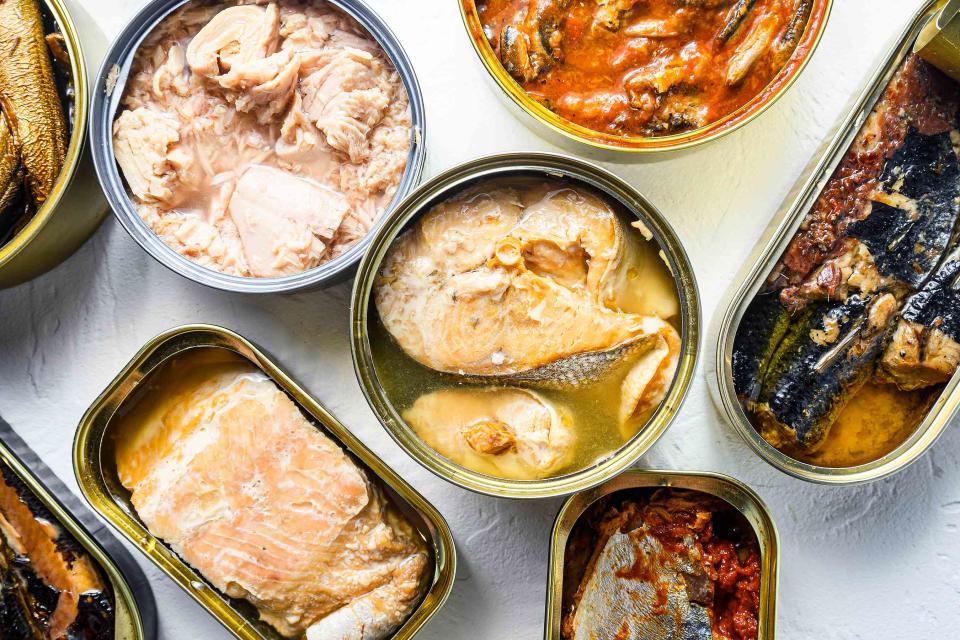Everything You Should Know About Tinned Seafood
These simple cans boast some fancy fish worth trying.

Ilia Nesolenyi / Getty Images
Various tinned seafoodsIf you’re like me, you’re on tinned fish TikTok (otherwise known as Tin-Tok). Tinned fish is more than the canned tuna from your lunchbox; think: smoked lemon pepper oysters, octopus in escabeche, or even wild mackerel in korma curry sauce.
San Francisco-based chef Ali Hooke, who started making Tik Toks (@alihooke) as a date-night tradition with her husband, is now regarded as a trendsetter in the Tin-Tok movement.
“It’s been really cool to encourage people to try tinned fish while advocating they look at the long history of it. Tinned fish is a large part of many cultures around the world, but somewhere along the way the masses got freaked out about it,” says Hooke. “It’s really exciting that the mainstream is discovering it again, especially for those who have loved it their whole lives. The ability to have fish preserved at its prime is the coolest part. For example, we have these mussels from Denmark that are unique to this region, and the fact that I can experience them whenever is special.”
Hooke and her husband try to keep a variety of tinned seafood in their diet. Some of her favorites are Nuri sardines in spiced tomato sauce, José Gourmet spiced mackerel pâté and Ramon Peña sardines in olive oil. As she notes, tinned fish and seafood have been around for centuries and allow you to enjoy preserved seafood from around the world in your own home. Here’s what you should know about these delicacies.
RELATED: This Is the First Tinned Salmon I've Ever Loved
What Is Tinned/Canned Seafood?
The term "tinned" (or "canned") seafood refers to food that has been processed, sealed in an airtight container, and heated for sterilization. As far as food safety is concerned, the combination of heat-based sterilization and airtight sealants keeps fish inside free of microorganisms.
How Long Does Tinned Seafood Last?
Typically, this method of food preservation can provide a shelf life of up to five years. But what about after you’ve opened it? Canned seafood, like any perishable food, should not be left at room temperature for prolonged periods of time. Once opened, it can be refrigerated in an airtight container for up to three days without spoiling.
How Long Has Tinned Seafood Been Around?
Food preservation techniques date back to prehistoric times, when humans pickled, salted, and smoked their food to make it last longer. However, the 18th century saw the advent of an efficient, effective method of preserving.
The origins of canning can be traced back to Nicola Appert, who is considered to be the "father of canning." Appert was a professional chef who opened a confectionery shop in Paris where he was passionate about preserving sweets in sugar through sterilization and canning. With the techniques that Appert developed, dairy, fruits, vegetables, and meat could be preserved without spoiling their flavor or texture through canning. Fishermen off the coast of France began using these methods to conserve sardines through canning. Following suit, other countries such as Spain and Portugal started tinning their own seafood, eventually dominating the market (you can find restaurants and shops based almost exclusively on tinned seafood in both countries).
RELATED: Somebody Donated a 33-Year-Old Can of Anchovies to a Food Bank
How Is Specialty Tinned Seafood Sustainable?
With sustainability and fair practices in mind, companies focused on tinned seafood offer quality products like octopus, tuna, and oysters. At Taylor Shellfish Farms, fish and shellfish are farmed along the Washington state coastline, then smoked or otherwise preserved before they are canned.
“We are extremely lucky to live among some of the cleanest waterways in North America,” says Jada Pearson, part of the family that has owned and operated the company for five generations. “The oysters we grow to smoke are pacific oysters and are grown via the long line method in Willapa Bay. The long line method is a traditional method to raise oysters for shucked meat. The oysters are grown on a line and are raised off the bottom of the ocean way floor, suspended by pipes providing better circulation and growth room for clutch (or oyster larvae) on all sides of the shell. This is typically a more labor-intensive method than growing on the bottom but holds a higher oyster yield per acre and better quality.”
Purveyors like Taylor Shellfish are seeing more interest in their products from consumers and restaurant owners. Interested in exploring tinned seafood to serve at a party? Check out 15 Ways to Use Canned Seafood, According to Chefs.

